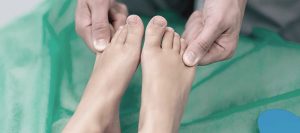
When a big toe stops getting along with the toe next to it, bad things happen. Specifically, when pressure on the joint of a big toe forces it to lean toward and crowd the second toe, a bunion can develop. There are few foot problems more common – and more disruptive – than bunions. They can make walking and standing painful and limit the kinds of shoes you can wear. Making matters worse, the prominence and pain of a bunion usually get more pronounced over time if left untreated.
Fortunately, there are several treatment options for bunions, ranging from at-home remedies that can alleviate pain and pressure to bunion surgery for more severe and advanced cases that can fix the underlying joint problem once and for all.
If you are experiencing pain or discomfort in the area around your big toe joint or notice a bump or protrusion in the same area, you likely have a bunion on your toe. But what, exactly, is a bunion?
To understand bunions, also called hallux valgus, you first need to understand the anatomy of your big toe. It contains two important joints. The larger of two is the metatarsophalangeal joint (MTP), which connects the first long bone of the foot (the metatarsal) to the first bone of the toe (the phalanx). The MTP joint is where bunions form.
A bunion develops because the MTP joint moves out of its normal alignment, shifting the long metatarsal bone towards the inside of the foot while also angling the phalanx bones of the big toe towards the second toe.
As time progresses, a painful bony bump that appears red and swollen will emerge at the site of the joint on the inside of the foot. You may first notice that bump only after months or years of the big toe working its way inward.
Bunions form for different reasons in different people. Some folks are genetically predisposed to bunions, so if one of your parents developed a bunion, you likely have a higher chance of getting one as well. For other people, usually women, swearing shoes with a narrow, pointed toe box can force the toes into an unnatural position and put severe pressure on the toe joint. Inflammatory conditions such as rheumatoid arthritis can also cause bunions.
At JAWSpodiatry, we always prefer non-surgical or minimally invasive treatments for bunions whenever possible and effective. But some bunions may need surgery to be fully resolved. Bunion surgery involves removing or realigning the soft tissue and bone in the area to bring the joint back into its correct alignment. To keep the bones in place, small screws, plates, or wires may be inserted as part of the surgery.
Is a Bunion Putting a Crimp In Your Step? Call JAWSpodiatry Today to Schedule an Appointment
At JAWSpodiatry in Hollywood, Florida, we utilize the most advanced and non-invasive techniques to reduce pain and speed recovery for individuals suffering from bunions and other foot and ankle problems. If you’d like to learn more about the innovative and effective treatments we provide or how we can help you with your foot and ankle issues, please call us today at (954) 922-7333 or contact us online to schedule a consultation.
- The Life-Changing Power of Cosmetic Foot Surgery - February 27, 2023
- What Are The Most Common Pediatric Foot Conditions? - October 5, 2020
- 4 Important Things To Know Before Having Foot Surgery - September 21, 2020



